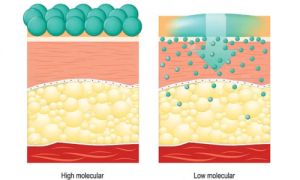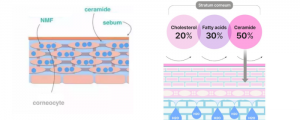Hyaluronic Acid vs. Ceramides: Which Works Better
In the field of skincare, hydration and moisture retention are always unavoidable topics. Whether it’s the dry winter or the hot summer, the issue of skin moisture loss consistently troubles many people.
Hyaluronic acid and ceramides are undoubtedly two of the most popular ingredients in the hydration and moisture retention domain. One is a classic ingredient hailed as the “king of hydration,” while the other is a “repair sensation” that has gained popularity in recent years. So, what exactly are the differences between these two ingredients?
Hyaluronic Acid: The “Evergreen Tree” of Hydration
Hyaluronic Acid (HA) is a naturally occurring polysaccharide in the human body, especially abundant in the skin, joints, and eyes. Its most notable feature is its ability to absorb and retain a large amount of moisture, making its moisturizing capacity truly “powerful”—1 gram of hyaluronic acid can absorb up to 1000 grams of water, thus earning the title of “natural moisturizing factor”.
–Mechanism of Action of Hyaluronic Acid
Hyaluronic acid works by forming a moisturizing film on the surface of skin, helping to lock in moisture. At the same time, it absorbs water from the environment, keeping the skin hydrated. Depending on its molecular weight, it operates at different skin layers:
- High-Molecular-Weight HA: Remains on the skin’s surface, forming a protective barrier to prevent moisture evaporation.
- Low-Molecular-Weight HA: Penetrates deep into the skin, providing internal hydration and increasing the skin’s moisture content.
Fig 1. Difference between high and low molecular weight hyaluronic acid
–Advantages of Hyaluronic Acid
HA provides immediate hydration effects. After using products containing hyaluronic acid, the skin instantly feels plump and hydrated, with a significant reduction in dryness. It is suitable for all skin types, whether dry, oily, or combination.
In addition to hydration and moisture retention, HA also has anti-aging benefits. This is because adequate moisture makes the skin appear firmer and can reduce the appearance of fine lines and dry wrinkles.
However, hyaluronic acid also has its limitations. It primarily focuses on hydration and has limited effects on repairing the skin barrier or improving sensitivity issues. If your skin barrier is already damaged, relying solely on hyaluronic acid may not fundamentally resolve the problem.
Ceramides: The “Newcomer Sensation” in Repair
Ceramides are lipids found in the intercellular spaces of the skin’s epidermal cells, constituting approximately 50% of the total intercellular lipids[i]. They are a crucial component of the skin barrier, acting like “cement” to tightly connect skin cells, preventing moisture loss and the intrusion of external irritants.
Fig 2. It accounts for about 50%
–Mechanism of Action of Ceramides
Unlike hyaluronic acid, the primary function of ceramides is not hydration but the repair and strengthening of the skin barrier. When the skin barrier is compromised, moisture loss accelerates, and the skin becomes dry, sensitive, and may even develop inflammation. Ceramides replenish the lost lipids in the skin, repair barrier function, thereby locking in moisture and improving the overall health.
–Advantages of Ceramides
For barrier damage caused by excessive cleansing, environmental stressors, or improper skincare, ceramides can effectively repair and restore the skin’s healthy state. Although ceramides do not directly hydrate, they provide moisture retention. By repairing the barrier, ceramides fundamentally reduce moisture loss, offering long-lasting hydration effects.
While ceramides excel in repair and moisture retention, their hydration effects are not as direct as those of hyaluronic acid. If your skin is only temporarily dehydrated without barrier damage, ceramides may not be as noticeably effective as hyaluronic acid.
Hyaluronic Acid vs. Ceramides: How to Choose
Since hyaluronic acid and ceramides each have their strengths, how do you choose the right ingredient for yourself? In fact, these two ingredients are not mutually exclusive but can complement each other.
–When to Use Hyaluronic Acid
- When the skin is temporarily dehydrated and needs quick hydration.
- When the skin is in a healthy state and only requires daily moisturization.
- When you want the skin to appear more plump and radiant.
–When to Use Ceramides
- When the skin barrier is damaged, leading to dryness, peeling, sensitivity, and other issues.
- When frequently exposed to dry environments, resulting in significant moisture loss.
- When you aim to fundamentally improve the skin’s moisture retention capability.
–Optimal Combination Strategy
For most people, combining hyaluronic acid and ceramides may be the best choice. Hyaluronic acid provides rapid hydration, while ceramides repair the barrier and lock in moisture. Together, they achieve a comprehensive skincare effect of “hydration + moisture retention + repair.” For example, in a daily skincare routine, you can choose a serum containing hyaluronic acid and pair it with a cream containing ceramides, satisfying both immediate hydration needs and long-term moisture retention and repair.
B2B: Where to Purchase Raw Materials
Stanford Chemical Company (SCC) is a trusted supplier of cosmetic ingredients such as hyaluronic acid and ceramides.
We Offer:
- Hyaluronic Acid Powder: High purity, non-animal, non-GMO, cosmetic grade, medical grade, food grade, injectable grade.
- Ceramides: Purity >98%, enhances intercellular cohesion in the stratum corneum.
Enjoy bulk purchase discounts and contract pricing.
FAQs
Q: What is the Main Difference Between Hyaluronic Acid and Ceramides?
A: HA primarily works to attract and retain moisture. Ceramides are mainly used to build and repair the skin barrier.
Q: In Terms of Moisturizing Effectiveness, Which is Better: Hyaluronic Acid or Ceramides?
A: HA excels in immediate hydration and increasing skin moisture, providing quick moisture to the skin. Ceramides are more effective for long-term hydration and maintaining the skin barrier.
Q: For Sensitive Skin, Which is More Suitable: Hyaluronic Acid or Ceramides?
A: Ceramides are more suitable for sensitive skin because they can repair and strengthen the skin barrier, reducing damage from external irritants.
Q: Can Hyaluronic Acid and Ceramides Be Used Together?
A: Of course. Combining them yields better results.
Read more:
Hyaluronic Acid and Collagen: The Perfect Combination for Healthy Skin
Sodium Hyaluronate: Uses, Molecular Weight, Production and Derivatives
[i] Coderch L, López O, de la Maza A, Parra JL. Ceramides and skin function. Am J Clin Dermatol. 2003;4(2):107-29. doi: 10.2165/00128071-200304020-00004. PMID: 12553851.


